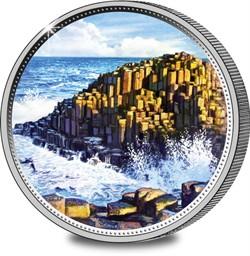-no-button.jpg)
 |
Location: County Antrim, Northern Ireland
Date completed: c. 50-60 Million BC
Designer/Builder: Caused by volcanic eruption
(or Finn MacCool, according to legend)
Function: Traditionally a pathway to
Scotland
|
You'll find the Giant's Causeway on the north coast of County
Antrim, Northern Ireland. It's an awesome spectacle, made up of
around 40,000 basalt columns.
Seeing the Giant's Causeway for the first time, it's easy to
believe the legends that grew up around it. One says that it was
built by the legendary Gaelic giant, Finn MacCool, who was
challenged by the Scottish giant Benandonner. Finn built the
Causeway from Ulster to Scotland so that he could meet Benandonner,
the Red Man. However, when he saw Benandonner approaching across
the Causeway, Finn realised he was much bigger than he'd thought.
He quickly ran to his home at Fort-of-Allen in County Kildare,
where his wife Oonagh disguised him as a baby. When Benandonner
arrived Oonagh said her husband was out hunting and showed him the
huge "baby", which made him wonder at the size of the father. Then
she showed him huge rocks, which she said Finn played catch with.
Benandonner could barely lift them. Terrified of meeting such a
huge man, he quickly made his way back to the Causeway. Finn chased
him, scooping up a huge clod of earth to throw. The hole filled
with water and became Lough Neagh - the largest lake in all
Ireland. The clod missed and landed in the sea, becoming the Isle
of Man! To stop Finn following him Benandonner tore up the Giant's
Causeway, which is why can now only see the beginning in Ulster and
the end in Staffa, in Scotland.
Less romantically, geologists say that around 50-60 million
years ago during the Palaeogene period, a huge volcano erupted
forming a lava plateau. As the lava cooled it fractured and formed
the distinctive pillars we see today. In a 2005 poll conducted by
the Radio Times, the Giant's Causeway was named the fourth greatest
natural wonder of the United Kingdom. The Causeway was first
mentioned in print in 1693 and after Dublin artist Susanna Drury
painted it in 1739 it came to the notice of the wider world. Today
most of the site in owned by the National Trust and the Causeway is
one of the most popular visitor attractions in Northern
Ireland.